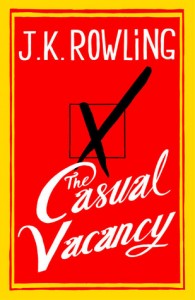J.K. Rowling, The Casual Vacancy, and Women
If J. K. Rowling had suffered from second-album-syndrome when writing her first novel since the Harry Potter series, nobody would have blamed her. How do you top something like Harry Potter? There has been no series since to capture the imagination of the masses, and I doubt there ever will be (and no, Twilight doesn’t count. Neither does Fifty Shades of Grey).
As someone who once refused meals because she wanted to read the fifth Harry Potter book uninterrupted, I was quite apprehensive when faced with the prospect of reading Rowling’s new release, The Casual Vacancy. Set in the small English town of Pagford, and centred on a local council election, it sounded dull as doorknobs. I didn’t want to be disillusioned about a writer who had inspired me throughout childhood, and whose creations remain as real to me today as they did the first time I read the word ‘Hogwarts’ at age 11.
The first thing I realised while reading The Casual Vacancy was that people had billed the book all wrong. This is not a book about a local council election. It’s barely a book about the fictional Pagford. It is a deep and complex exploration of the human condition, painted against a backdrop of class struggles, adolescent mood swings, and societal expectation.
It is, in my opinion, a brilliant novel. There is certainly something jarring about reading a book by the same woman who brought us Harry Potter and Ron Weasley, sharing chocolate frogs on the Hogwarts Express, and to stumble across words like ‘rape’, ‘balls’, ‘huge cock’, and ‘tits’. It took a while before I could really disassociate one novel from the other, and realise that Rowling is as multi-faceted as her characters.
But having finished the novel, the thing that really struck me about The Casual Vacancy was the cynical portrayal of the residents of Pagford, which felt so at odds with the glorified Harry Potter crew. Particularly in terms of female characters, Rowling has tapped into the seedy, dark side of humanity that just wasn’t present in her other work, and for good reason.
There is really no comparison to be made between Harry Potter and The Casual Vacancy – they are completely separate novels, and have nothing in common other than the imagination that created them. I’m not going to compare the two any longer, other than to say this – the female characters in Harry Potter were amazing role models for me when I was growing up. From Hermione Granger to Molly Weasley to Professor McGonagall, right through to the deceased Lily Potter; I always felt like they were women to be looked up to, to be revered in a way.
Reading The Casual Vacancy, it was almost jarring to discover that Rowling is not immune to the failings of the fairer sex, by any means. Just as her male characters in the novel are often dishonest, narcissistic and downright evil, so are the numerous women who fill its pages.
From Ruth Price, who’s husband is violent and aggressive, and who she excuses even when he turns his anger into physical abuse against her and her sons, to Shirley Mollison, elderly and evil, and completely focussed on keeping her husband in high esteem and everyone else in their place, Rowling has tapped into the complexities of human nature which spare no one.
Rowling’s women in The Casual Vacancy use sex as a weapon, are often in awe of the men they are with, and are used to playing second fiddle to male counterparts who steal the show.
The most self-actualised woman in the entire novel is 16-year-old Krystal Wheedon, daughter of a junkie and the ‘town bike’. Krystal stands up for herself, takes care of her younger brother, and is determined to figure some way out of her painful existence living in the council flats that are a cause for much debate within the town.
But in contrast to Krystal is Sukvhinder Jawanda, driven to self-harm by hurtful and methodical bullying at school; and Samantha Mollison, obsessing over far younger men to distract herself from her failing business and equally failing marriage. Each character is deeply flawed, and most make no recovery by the end of the novel.
This isn’t to say, however, that The Casual Vacancy offers a bleak and negative view of women – in fact, I would argue the opposite. In creating such a unique cast of characters, each complex and developed independently, and each demonstrating a different range of concerns and issues, Rowling has effectively shown us the gaps in society, the problems which we don’t necessarily dwell on.
Domestic violence, rape, dissatisfaction, teenage bullying – these issues form the foundation for the characters’ lives, and in dealing with them, Rowling shows us how resilient, unique and complex women (and men) are, and how harrowing the problems are that they face.
It was galling to realise that there would be no Hermione Granger in The Casual Vacancy – no quick-thinking, intelligent, thoughtful young woman for me to look up to.
But despite being characterised by malaise and unhappiness, the women in The Casual Vacancy are more relevant to our lives and experiences than any number of fantasy heroines could be.
Do you love independent media? Can’t get enough of intelligent, thoughtful feminist content? Want to see writers actually get PAID for their work? Please donate to Lip through Pozible today, and help keep the mag alive!
(Image credit)


